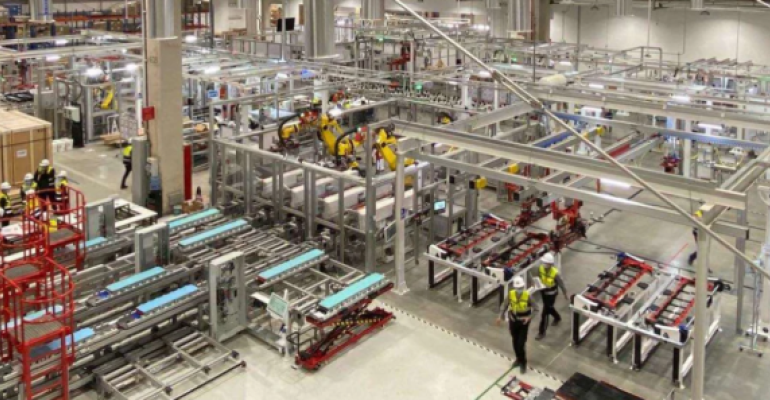Akira Yoshino, co-winner of the 2019 Nobel Prize in Chemistry for his groundbreaking research in lithium-ion batteries, remains bullish about the markets for both batteries and electric vehicles despite mounting losses by automotive OEMs.
In an interview with Wards, Yoshino says “EVs accounted for 12% of global passenger vehicle demand in 2020. This year, 2023, it looks like they will reach 16%. Looking at other products like televisions, refrigerators and personal computers, the 16% threshold is key.”
Yoshino headed Asahi Kasei Corp.’s battery program in the 1980s when the supplier received its first patent. Now 75, he wasn’t alone in trying to achieve a technological breakthrough. Research on li-ion batteries began in the 1970s at Exxon Research & Engineering Co., Bell Laboratories, the Institute National Polytechnique de Grenoble and Sony Corp. The research involved such names as M. Stanley Wittingham, John Goodenough, Rachid Yazami and Yoshio Nishi.
 Wittingham and Goodenough were co-winners of the 2019 Nobel Prize with Yoshino (pictured, left).
Wittingham and Goodenough were co-winners of the 2019 Nobel Prize with Yoshino (pictured, left).
Yoshino, now teaching at Meijo University in Nagoya, is optimistic about the U.S. market, which has fallen behind China and Europe in EV sales. The market, which received a boost following passage of the Infrastructure, Investment & Jobs and Inflation Reduction acts, could be in jeopardy, however.
“A lot will hinge on next year's presidential election,” Yoshino says. “If (former U.S. President) Donald Trump is elected, there is a possibility that the Biden administration green initiatives could be derailed.”
Yoshino also discusses the battery-material supply chain, a big problem in the U.S., Europe and Japan as China is the dominant producer of most processed materials that go into batteries.
“I think the supply chain in the U.S. is developing. There’s a lot of movement,” Yoshino says. “And Japanese battery manufacturers are looking at plans to set up manufacturing in the U.S., including cathodes, anodes and other components.”
Yoshino acknowledges the Japanese battery industry is dominated by one manufacturer, Panasonic, which supplies both Tesla and Toyota. He believes, however, that Panasonic will also have opportunities with the Detroit Three “because of U.S. policy to exclude Chinese manufacturers from the supply chain. So, North America represents a good opportunity,” he says.
Globally, Panasonic has fallen behind CATL, LG Energy Solution and other Chinese and Korean suppliers. But it still supplies Tesla, is a partner in Tesla’s gigafactory in Sparks, NV, and has joined Toyota in its $13.9 billion battery plant project in Liberty, NC.
“With EV market share at around 12%, the global market is still in the early stages,” he says.
In the case of CATL, currently the world’s No.1 li-ion battery supplier, Yoshino acknowledges the Chinese manufacturer has a big advantage because of the volume of EVs using its batteries and the use-case data it has gathered.
As for Japan, Yoshino identifies only one battery manufacturer other than Panasonic that might be able to compete on a global scale: GS Yuasa Corp.
“A lot depends on how Japanese auto manufacturers move into EVs,” he said. “Honda still hasn’t prioritized EVs. Its main supplier in Japan is GS Yuasa.”
GS Yuasa also supplies Mitsubishi.
Yoshino believes there is still time for the supplier to catch up.
Meanwhile, Toyota is investing in solid-state technology. “But mass production technology isn’t there yet,” warns Yoshino. “For solid-state batteries to become practical, we need to be able to mass-produce them. That’s going to take a bit more time.”
Toyota, in revealing its EV battery plan in June, said the battery will be ready for commercialization in 2027 or 2028. “But that might mean 10,000 units or a few tens of thousands of units,” he says, “which is not mass production.”
Yoshino thinks mass production is more likely to occur sometime after 2030.
“It’s going to take at least that time to move from a few thousand or tens of thousands of units to hundreds of thousands or millions,” he says.
Meanwhile, he thinks it is more likely that a new bipolar battery, also announced in June, will succeed Toyota’s current lithium-ion batteries. The first bipolar unit identified by the automaker uses LFP (lithium iron phosphate) as the cathode material; the second, NCA (lithium nickel cobalt aluminum oxides).
Toyota claims its bipolar battery can increase EV driving range to 1,000 km (620 miles), according to Yoshino. He adds that the automaker, although not widely known, switched to a bipolar configuration for nickel-metal hydride batteries in the latest version of the Aqua hybrid.
“Thus, it is not clear if Toyota will continue switching to li-ion for hybrid vehicles,” he says.
What comes next?
“I believe solid-state, then sodium-ion. After sodium-ion we don't know yet. There are a lot of candidates, but none has shown to be a clear next option.”
Yoshino doesn’t offer a timeline for when sodium-ion will be commercialized.
Looking deeper into his crystal ball, Yoshino thinks it will be difficult for cell costs to reach $50 per kilowatt-hour, considered the level needed to make the conversion from combustion-engine cars to battery-electrics.
“Fifty dollars is surely a target,” he says, “but I don't think it can be reached for the time being. I think the industry has reached $100 on a cell level and roughly double that for a pack.”
Meanwhile, Yoshino won’t reveal when he thinks 50% of new cars sold globally will be battery powered.
“I think it’s probably going to be faster than we expect and will be linked to the number of fueling stations (for ICE vehicles), which are decreasing rapidly in Japan and elsewhere in the world.
“Cars are much more fuel efficient than they used to be, probably 30% better. As a result, smaller stations won’t be able to stay in business.
“Gasoline and electric vehicles are not going to coexist together forever,” he says.





